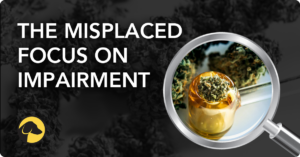
Recruit, Hire, Test, Repeat; How to Stop This Endless Cycle
In the 1993 movie ‘Groundhog Day,’1 narcissistic weatherman Phil Connors (played by Bill Murray) finds himself stuck in an endless time loop while covering – you guessed it – the annual Groundhog Day celebration in Punxsutawney, Pennsylvania. Only after re-evaluating his life and choices does Phil break the cycle.
Just like Murray’s character, employers today may feel stuck in an endless loop of recruiting, hiring, and drug testing, only to lose strong candidates and repeat the process all over again.
“We just had a hiring event where nearly 70 people showed up, and after we told them they would be tested for THC, most of them didn’t show up the next day, and a few failed the drug test. We lost 100% of our candidates that day.”
– Construction Company
Why is this happening? The simple answer is, in most cases, zero-tolerance drug testing policies are no longer compatible with ever-evolving cannabis laws. Employers may need to re-evaluate their drug testing policies, programs, and testing methods to finally break this endless cycle.
A GROUNDHOG DAY TALE
Organizations across all industries are finding it difficult to secure the talent needed to deliver goods and services to their end markets. Many employers are hosting recruiting and hiring events in hopes of hiring applicants quickly and effectively. While some employers succeed in securing talent through these activities, others may struggle and are often hindered by overzealous testing policies.
This is the situation an employer – let’s call him Walter – finds himself in. After hosting a recruiting event, his company fails to hire a single employee. The issue is not the lack of highly qualified candidates, but the company’s strict pre-employment testing policy. After completing successful introductory interviews, a significant number of potential hires decides not to return once they hear they will be tested for cannabis. The few who do return for testing fail to pass because the legacy tests Walter’s company uses reflect cannabis use that occurred days, weeks, and months before the event.
Even though Walter is not hiring for safety-sensitive positions, the company’s testing policies are rooted in zero-tolerance, which means each candidate who fails the pre-employment cannabis test is ineligible for employment. After all of Walter’s efforts and expenses to recruit a new slate of hires, he has nothing to show for it.
Walter finds himself in an endless loop – recruit, hire, test, repeat – of unsuccessful hiring attempts. As the company becomes desperate, it considers eliminating THC testing, but that decision comes with incredible risk and concern. Recent drug testing data shows urine testing cannabis positivity in the general U.S. workforce has increased by 50% over the past five years – the same period when some employers stopped testing for THC. More alarming, the post-accident cannabis positivity rate was nearly 63.4% higher than the pre-employment positivity rate.2 These statistics show that excluding THC from the panel for reoccurring testing reduces the deterrence value of drug testing.
Walter realizes that to break the loop, he needs to reevaluate the company’s workplace cannabis testing policy and investigate new technology to better align with emerging state cannabis laws.
DÉJÀ VU
Walter’s company decides to make three significant changes to its workplace cannabis testing policy and program to balance workplace safety and employee privacy.
First, the company updates its zero-tolerance approach to a policy that better addresses the impacts of cannabis legalization. After all, more than 134 million adults (21 and over) live in states with legal access to cannabis.3
Second, the company moves from pre-employment testing to onboarding testing backed by continuous monitoring. Although pre-employment testing can effectively screen candidates using drugs during the hiring cycle, this approach is far less effective when used as a standalone reason for testing. Drug testing is most effective when implemented as part of a comprehensive testing program with continuous monitoring to help navigate evolving cannabis laws and lower exposure to risk.
Finally, the company decides to implement a cannabis breath test to isolate detection to recent use surrounding the workday. Aligning test results to reflect use that surrounds the workday empowers employers to deter use, attract and retain employees, and foster safe and fair work environments. Additionally, a breath test with a recent use detection window aligns with emerging state laws, allowing employers to continue testing for cannabis in a fair manner.
Walter’s next hiring event starts similarly to the previous ones but ends with tremendous success. By creating workplace testing policies around the goals of deterring recent cannabis use as part of its onboarding process and continuously during employment, the company recruits and retains a large number of employees to meet its business goals.
BREAK THE CYCLE
Outdated workplace cannabis testing policies and programs can make employers feel stuck in a Groundhog Day cycle of recruit, hire, test, repeat. But when organizations modify drug testing policies and introduce technologies to help decrease risk, increase safety, and improve the candidate experience, employers like Walter can be assured they aren’t waking up to an endless loop of unfortunate hiring challenges.
To break the cycle, connect with our sales team for information about the HOUND® CANNABIS BREATHALYZER.
Footnotes
1 Rotten Tomatoes
2 Quest Blog
3 Census

February 2, 2023
By CASEI MALONE
Share












